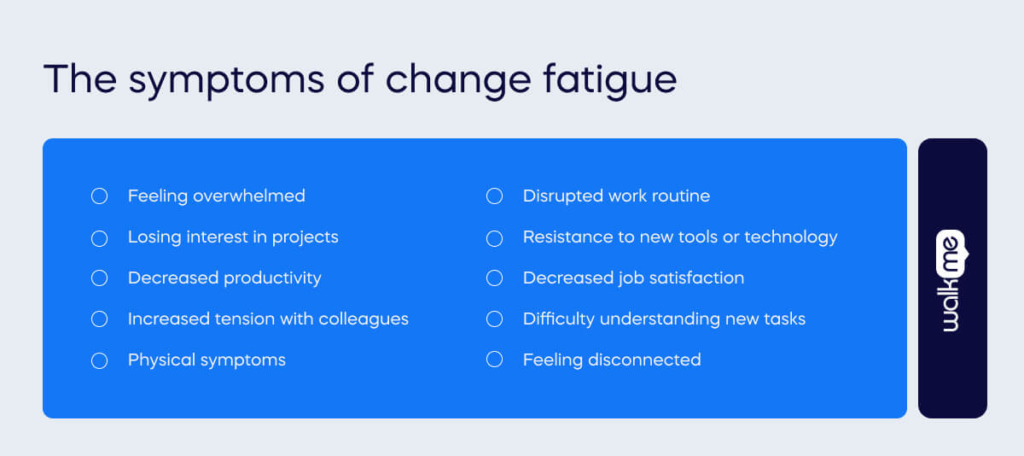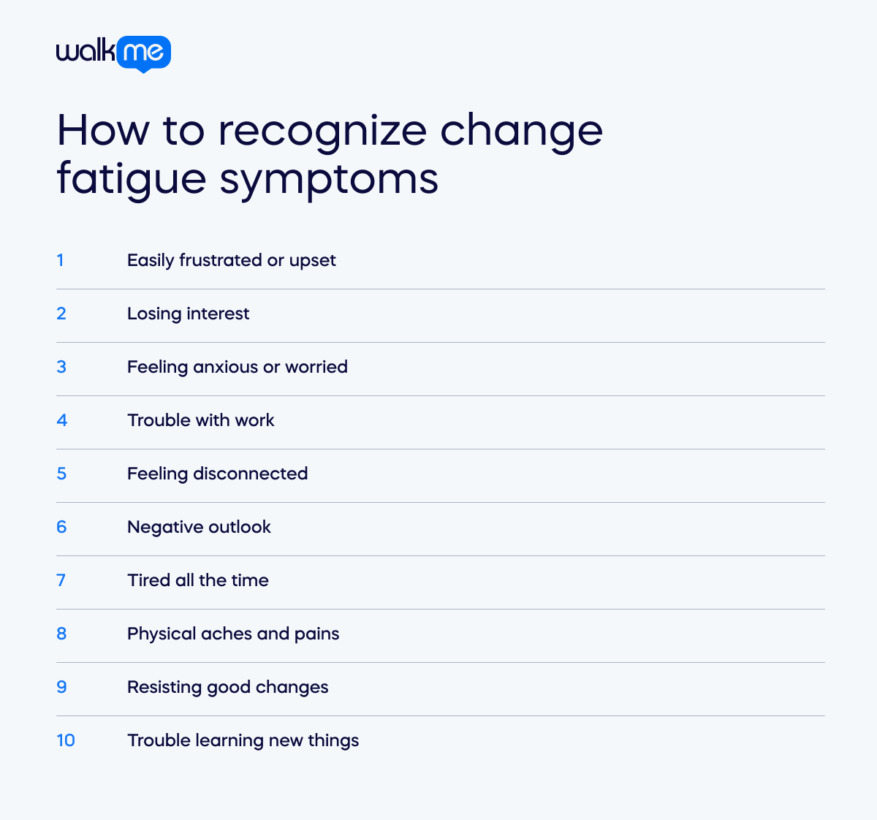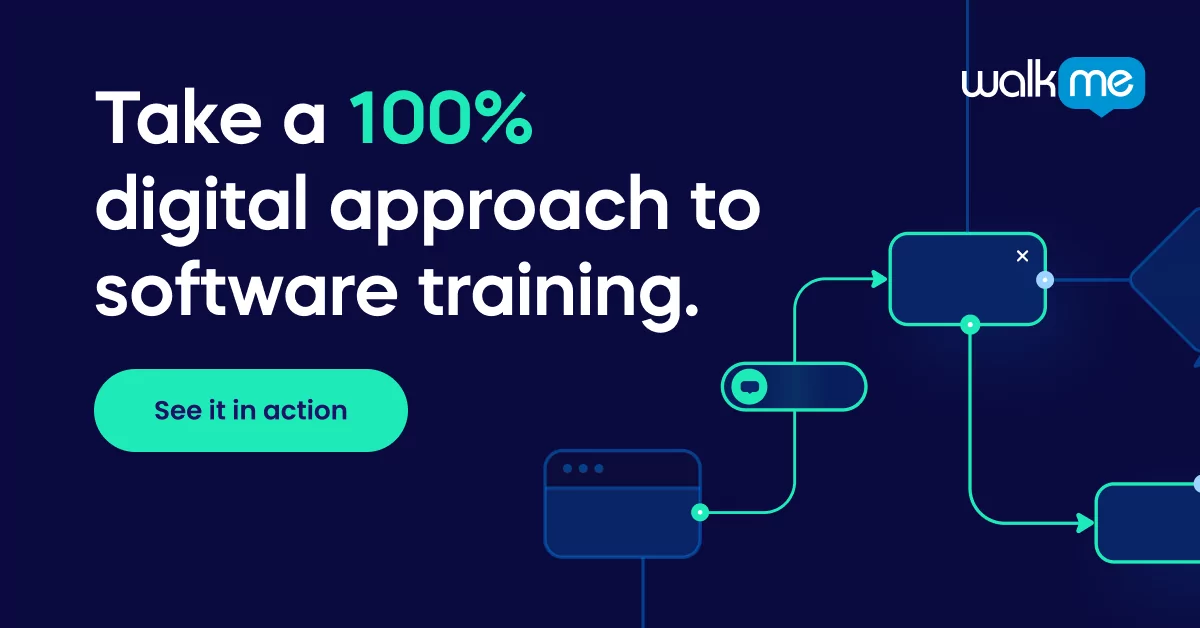Experiencing constant change at work can be exhausting, leading to what’s known as “change fatigue.”
It’s like when you’ve been on a roller coaster for too long; the constant ups and downs wear you out. Symptoms include feeling overwhelmed, stressed, or even apathetic towards new changes.
Change fatigue can affect your productivity, mental health, and overall well-being. Understanding these symptoms is crucial for coping and adapting amidst ongoing changes.
In the past year, the average employee encountered ten planned changes in their workplace. This constant flux is causing symptoms of change fatigue to emerge among many.
This article will explore the symptoms of change fatigue and help you spot them. Recognizing these signs is key for handling constant change and identifying them in yourself and others.
What is change fatigue?
Change fatigue happens when a workplace or a person experiences too many changes in a short time.
This causes new leadership, company reorganizations, or constantly shifting work processes. Change fatigue leads to exhaustion, feeling overwhelmed, or lacking motivation for new projects or ideas.
People might become frustrated, have trouble concentrating, or resist beneficial changes. It’s important to recognize change fatigue because it can make it harder for positive changes to be successful. This can impact both individuals and the workplace.
What are the symptoms of change fatigue?

Understanding the signs of change fatigue is important for businesses. These signs can be things like workers getting upset, not caring about their work, or not doing as much as they used to. If companies don’t address change fatigue, workers might leave, or it could make positive changes harder to achieve.
Let’s take a closer look at the symptoms of change fatigue:
Feeling overwhelmed
In the workplace, change fatigue can make you feel like you’re drowning in tasks. You might have an overflowing inbox, a never-ending to-do list, and too many meetings crowding your calendar. Deadlines may feel impossible to meet, and even small requests or changes to your routine can leave you feeling completely overwhelmed.
Losing interest in projects
Projects that once sparked your creativity and held your interest might feel tedious and unrewarding. The initial enthusiasm for a new challenge or initiative can dwindle, making it difficult to find the motivation to put in your best effort. You may procrastinate, disengage with your work, or go through the motions.
Decreased productivity
Change fatigue saps your energy, focus, and mental clarity. You might take longer to complete tasks, make more mistakes than usual, or need help to begin work. This reduced productivity can impact your output, team projects, and overall deadlines.
Increased tension with colleagues
When overwhelmed and stressed, you’re more likely to become irritable or short-tempered with coworkers. Miscommunications can happen more easily, and disagreements about handling changes may escalate into full-blown conflicts. Increased tension within the team creates a negative work environment for everyone, affecting morale and overall collaboration.
Physical symptoms
Change fatigue at work can manifest in physical ways. You might experience headaches, difficulty sleeping, changes in appetite, muscle tension, or a general feeling of being unwell. These physical symptoms can further affect your mood, focus, and overall work performance, creating a vicious cycle.
Disrupted work routine
Changes at work often throw off your usual routine and force you to adapt on the fly. New procedures mean re-learning how to do once-familiar tasks, and a constant influx of revised instructions can be overwhelming. You may struggle to prioritize effectively or feel like you are constantly reacting to unexpected issues rather than proactively managing your workload.
Resistance to new tools or technology
Implementing new tools or technology requires learning and adaptation. Change fatigue can make this much harder. You may actively resist these changes, feeling like they are an additional burden rather than something that might make your job easier in the long run. This resistance can hold you back professionally and create roadblocks for team projects.
Decreased job satisfaction
Feeling constantly overwhelmed, disengaged, and unable to keep up negatively impacts your overall satisfaction at work. This can lead to low morale, a lack of enthusiasm for your role, and a decreased sense of purpose in your daily tasks. Over time, this decline in job satisfaction can lead to serious burnout.
Difficulty understanding new tasks
With change fatigue, your mental clarity and cognitive function suffer. Following instructions for new processes, understanding revised protocols, or adapting to new ways of doing things may feel incredibly challenging. This can lead to frustration and make you doubt your own abilities.
Feeling disconnected
Change fatigue can cause you to withdraw and feel isolated at work. You might disconnect from your team, losing interest in collaborative projects and feeling less invested in shared goals. A sense of disconnection can even lead to a growing feeling that you don’t fit in within the changing workplace environment.
How to recognize change fatigue symptoms

Recognizing change fatigue symptoms early helps businesses keep employees happy, productive, and less likely to leave.
Let’s explore how to recognize change fatigue symptoms:
- Easily frustrated or upset
People with change fatigue often have a shorter fuse. They might get angry, irritated, or snappy over small things that wouldn’t typically bother them. This heightened emotional response is a sign that they’re being stretched too thin and lack the usual resilience to handle even minor inconveniences.
What businesses can do
Create a culture where it’s okay to express feelings and ask for help. Provide stress management resources and promote healthy ways to cope with pressure. Encourage managers to check in regularly with employees, offering support and acknowledging challenges.
- Losing interest
Tasks or projects that were once exciting might feel boring, repetitive, or pointless. A lack of enthusiasm or a “just get it done” attitude can signal change fatigue. The constant mental effort of adapting erodes initial excitement and makes work feel tedious.
What businesses can do
Explain the purpose behind changes and connect them to the employees’ values. Offer opportunities for growth, learning, and autonomy to keep work engaging. Celebrate small wins and recognize the effort employees put into adapting to changes.
- Feeling anxious or worried
Constant change can lead to feeling stressed, overwhelmed, and worried. People with change fatigue might have trouble focusing on the present due to anxiety about future changes or uncertainties. They might feel like they can never fully relax.
What businesses can do
Be transparent and communicate clearly about upcoming changes. Provide timelines, rationales, and opportunities for employees to ask questions or provide feedback. Encourage mental health breaks and time away from work to de-stress.
- Trouble with work
Change fatigue makes concentrating, prioritizing tasks, and maintaining energy levels hard. People might make more mistakes, take longer to finish tasks, or even avoid work altogether out of overwhelm. This affects both their individual performance and the team.
What businesses can do
Offer more training and support for new procedures or technologies. Prioritize the most important changes and avoid overwhelming employees with too much at once. Create a culture where it’s acceptable to ask for clarification without judgment.
- Feeling disconnected
Change fatigue can make people feel isolated or withdrawn. They might lose interest in teamwork, avoid socializing with coworkers, or seem less invested in the company’s goals and overall progress. Disconnection is a way of mentally protecting themselves from further change.
What businesses can do
Promote opportunities for team bonding and social interaction. Encourage mentorship or buddy systems for employees going through similar changes. Create space to celebrate successes and recognize individual contributions within the context of changes.
- Negative outlook
People struggling with change fatigue might become more negative or cynical. They may complain more frequently, express frustration regularly, or find it hard to see anything positive about changes happening at work. Negativity can be an expression of the mental toll they’re facing.
What businesses can do
Actively gather employee feedback and demonstrate how their input shapes decisions. Provide a safe space to air concerns about changes and be receptive to constructive criticism. Focus on celebrating achievements and the progress being made.
- Tired all the time
Even with enough sleep, someone with change fatigue may feel mentally and physically exhausted. This exhaustion makes it difficult to concentrate, stay motivated, or feel mentally sharp enough to tackle challenges.
What businesses can do
Promote a healthy work-life balance and encourage employees to take breaks and use their time off. Be flexible with work arrangements to allow for rest and personal commitments. Consider offering wellness programs or resources to support employees’ overall well-being.
- Physical aches and pains
Stress and feeling overwhelmed can show up in the body. Headaches, stomachaches, trouble sleeping, muscle tension, or feeling unwell can all be signs of change fatigue. Our bodies react to mental strain as well.
What businesses can do
Offer ergonomic assessments and resources for a comfortable workspace. Promote health initiatives and access to resources supporting physical and mental health. Acknowledge that stress has physical consequences and encourage seeking help when needed.
- Resisting good changes
A clear sign of being overwhelmed is when people push back against any change, even ones that logically seem beneficial or would make their lives easier. This indicates they have no energy left to adapt.
What businesses can do
Consider slowing down the pace of change, if possible. Involve employees in decision-making processes about change or allow for customization where it makes sense. Acknowledge that resistance is a sign of overload and address the root causes.
- Trouble learning new things
With change fatigue, learning new things at work feels much harder than it should. This signals mental fog and an overworked brain struggling to focus.
What businesses can do
Ensure training is well-designed and presented in accessible ways. Provide different learning formats (written instructions, hands-on demos, etc.) for different learning styles. Be patient and offer multiple opportunities for training.
How to avoid change fatigue
Change fatigue isn’t just a feeling—it has real consequences. Tired, stressed-out employees make more mistakes, struggle to focus, and lose interest in their work. If companies ignore the signs, the best people might leave, and even well-planned changes can fail.
But it doesn’t have to be this way. When businesses understand change fatigue, they can take steps to help. Clear communication about why changes happen and how they’ll help makes a big difference.
Giving employees time to adjust and celebrating their hard work builds trust. It’s also important to provide support, listen to feedback, and be flexible when possible.
Addressing change fatigue takes effort, but the rewards are worth it. When employees feel supported and have the tools to cope, they’re better equipped to handle even the biggest transitions.
This doesn’t just boost morale; it keeps businesses strong, ensuring people are ready to take on the challenges of tomorrow.


